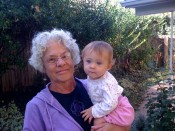Separating the Wheat From the Chaff
By Kate[For those of you who have no idea what this means, it is a term used when you winnow the wheat after it is harvested. The chaff, or the hulls, dry straws and stalks, are separated from the grains of wheat – the wheat is stored or taken to the miller for grinding and the straw is used for animal bedding, mulch, and compost. It’s also used as an expression and applied to many different situations.]
So let’s take a dispassionate look at our food and separate the wheat from the chaff. Never mind all the emotion and slinging of mud – let’s get down to basics. Food is our focus activity three or more times a day. We want it to taste good, look good, and nourish us so that we stay well and feel good. We want the wheat without the chaff.
For pretty much the entire history of humans on the earth, food has been a very direct experience. You grew it, you exchanged it with your neighbors, stores carried the staples, and fixing it was up to a person in the house – for the most part. We started to fall in love with convenience, time-savers, prepared foods of all kinds. Life was good and more and more Mommies were out of the kitchen! Suddenly there was a hamburger joint, and a pizza parlor; sometimes even a Chinese restaurant. In the cafeteria, the Lunch Ladies still cooked everything from scratch. Most of the food was supplied locally and it tasted good.
After the extensive interstate road system went in during the Eisenhower years, food was trucked farther and farther. As the distance from field to table increased, so did the preservatives and chemicals in our foods. Even the fresh veggies had to be sprayed to prevent rot on the way to market. No blemishes allowed in our supermarkets!
Industry had it made! Things we love to eat started to be manufactured with chemicals, and esters, and artificial color to the exclusion of all natural ingredients. It was no longer food. As the chemicals increased in our diet, our bodies found it harder and harder to get rid of these toxins fast enough. Every day another load of chemicals came into our bodies; and every day we struggled to rid our bodies of all the chemicals. We also stopped noticing all the small differences in our bodies and in our health.We stopped noticing we just didn’t feel as good as we used to.
Gradually, all the chemicals in our food, in our water, and in our air became so prevalent and common that a new born baby has 200 chemicals in their little bloodstream at birth before ever having the first drink of Mother’s milk. This is very serious. This means that when that baby takes in food for the first time – even Mother’s milk – that child is increasing the amount of chemicals in their tiny body because it’s in the Mother’s bloodstream as well. Is it any wonder the number of children with chronic conditions of all kinds has gone up so high? For the first time, the prediction is that the parents of today will outlive their children!
So here’s an experiment you can do on your own. Grab one of your favorite foods that is prepared for you. Read what’s on the label and for every ingredient that has a chemical name, look it up. I did it and was shocked by what I found. Sodium benzoate or benzoate of soda is a very common preservative. It’s been in use since I was a child and before. In Wikipedia the description includes the words “a known carcinogen” and says it becomes more toxic when combined with an acid. Like orange juice? Vinegar? Wine? They’re having a party in my tummy!
So go for it, Friends! Keep track of what you are eating. Make a list for the refrigerator and have everyone old enough to read put the ingredients of the food eaten on the list. Check off each ingredient every time you eat it again. One night sit down and look up each item to see what you are eating – and how much of it. Then talk about ways to reduce the chemical overload on your bodies.
Here are a few good rules of thumb: If it isn’t the color of food, it isn’t food. Red and blue dyes are very upsetting to some kids systems. Even the amount in their toothpaste can ‘set them off’. Until genetically modified foods (GMO’s) are labelled, avoid soy and soy products, corn and corn products, canola or rape seed oil, cottonseed oil, and beet sugar. All of these products have been shown to be very harmful to all living creatures after they are genetically modified. Apparently we don’t do well with a load of pesticides in our food either!
You can choose, you know. You can change the system with your choices. This is being proven again right now in the world. Everyone deserves clean food. For the moment, that is only possible if we eat whole foods, organic foods, foods we grow, and foods that are labelled “No GMO’s”. It’s tough to change; but the alternatives are truly grim! If we keep eating chemicals every day in everything we eat, we will all be very sick.
